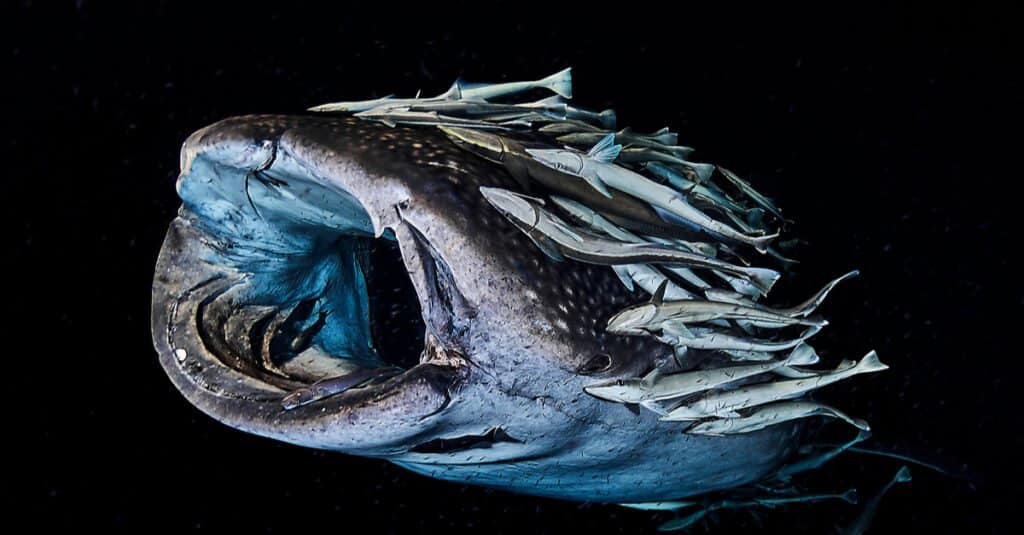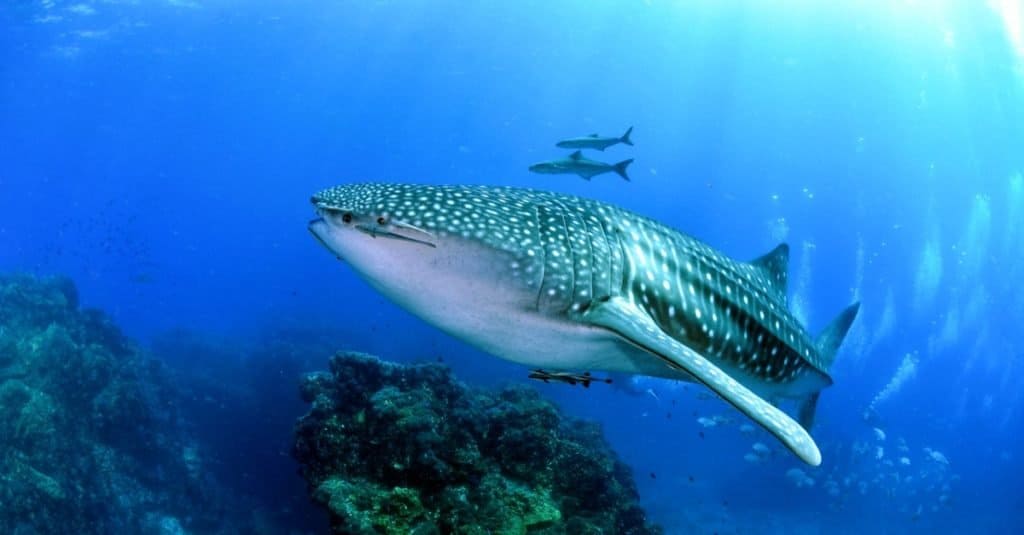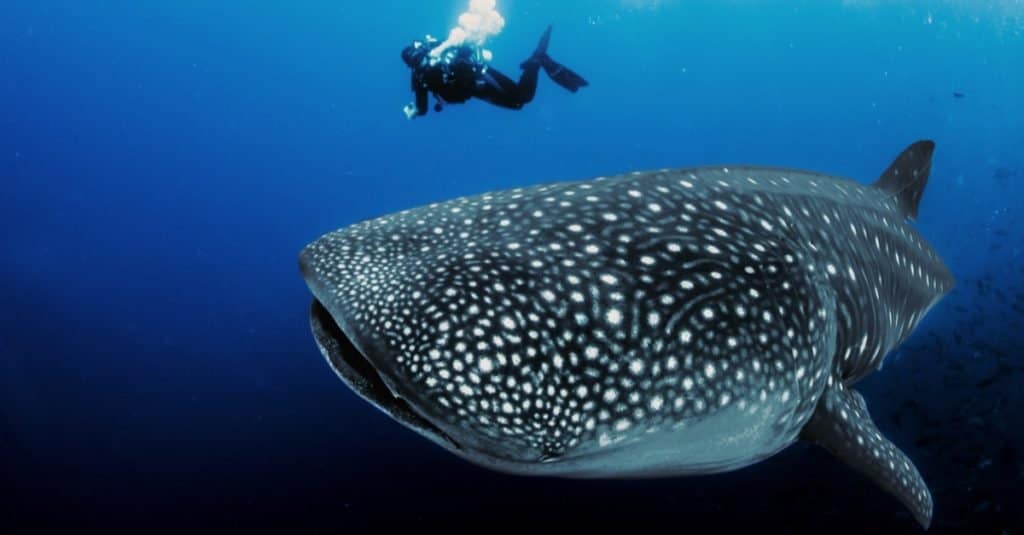Whale sharks are among the biggest giants on planet earth. When it comes to fish, whale sharks hold the title as the largest fish alive and have been roaming Earth’s oceans for millions of years. Although these massive creatures may seem imposing, they are incredibly gentle and can be seen in nearly all of the world’s oceans. To keep their massive appetite fed, whale sharks must constantly move to get their daily 45-plus pounds of food to live. Let’s explore a bit more about these animals and learn where whale sharks live and where they migrate across the world.
Where do whale sharks live?

Whale sharks live in temperate and tropical waters across the world.
©Alex Rush/Shutterstock.com
Whale sharks are the largest species of fish on the planet, as well as the largest non-vertebrate animal in the world. As the case is with many of the world’s largest animals, they live in the ocean! Let’s take a deeper dive, however, and learn exactly where these giant fish live.
Whale sharks are almost always found in temperate to tropical waters across the world. More specifically, they are found between the latitudes of 30°N and 35°S. Temperate water is technically an ocean climate that is between 32 degrees Fahrenheit and 72 degrees Fahrenheit, but whale sharks are almost never found in water that drops below 70 degrees. Tropical water ranges from 68 degrees Fahrenheit and 95 degrees Fahrenheit, and whale sharks can survive in these climates year-round. The preferred water temperature for a whale shark is between 70 and 80 degrees, but they are occasionally found outside this range.
Typically, whale sharks can be found off the coast of India, the Maldives, Belize, South Africa, Mexico, and Southeast Asia. These warm coastal climates are home to their favorite foods and often have nearby feeding grounds. During the year, they will migrate across the world in search of food and in order to mate at instinctual mating grounds.
Although it’s rare, sightings at the extreme ends of their preferred climate have happened. These sightings have happened as far north as the Bay of Fundy in Canada and as far towards the south as Victoria, Australia.
What does their habitat look like?

Whale sharks swim in the open ocean but head into shallow water to feed.
©weera bunnak/Shutterstock.com
Whale sharks can be found in shallow waters as well as the open ocean, but they usually stick to the shallows. Their food source (plankton and small crustaceans) are often in the shallower regions, pulling the sharks closer to shore. In the shallows, whale sharks often hang around lagoons surrounding coral atolls and reefs since the water is warmer and food is abundant.
As pelagic sharks, they do migrate and can often be found swimming in the open ocean. While many species would find this trek treacherous, the sheer size of these fish keeps them from danger. While in the open ocean, they stay out of the depths and occasionally venture down below for food. Their dives usually bottom out around 1,900 meters, but they rarely test their limits below that.
Why do whale sharks migrate?
There are two primary reasons that whale sharks migrate: food and breeding opportunities. Whale sharks embark on some of the largest migrations in the animal kingdom, with some subgroups traveling from Panama to the Mariana Trench in 841 days. This migration totaled over 20,000 km and was the largest recorded migration of a whale shark.
Food is important for a whale shark. In order to keep up their weight (all 40,000 lbs worth), they need to eat at least 2% of their body weight per day. For a smaller whale shark that may be only 45 pounds, but the largest whale sharks may require about 800 pounds of food per day!
Migrating allows whale sharks to live in the richest feeding grounds, as well as avoid competition with other filter-feeding species. During the summer months, whale sharks head towards the poles as the water warms to take advantage of the previously inaccessible feeding areas. As the water cools, they head towards the equator and stay in the nutrient-rich tropics that the waters provide. Although they are primarily solitary fish, their migration habits have them occasionally forming hotspots. Some of the famous hotspots are the Yucatan Peninsula, near Mexico, Belize, Japan, and a few others.
Aside from food, whale sharks also migrate to breeding and pupping grounds. Although there are large gaps in the scientific understanding of the whale shark reproduction cycle, migration surely plays a role. Since whale sharks give birth to live “pups,” finding safe places to do that is one of the primary factors that scientists attribute to female shark migrations. The current belief is that females prefer isolated islands in the middle of the ocean free from predators. In 2009, a baby whale shark was found off the coast of a Phillipino island, potentially confirming the area as a pupping ground. Additional pupping grounds include Ticao Pass and St. Helena.
Where can a human see whale sharks?

Whale sharks migrate to the Yucatan Peninsula and Ningaloo, Australia, each year, allowing for a booming eco-tourism industry.
©Lindsey Lu/Shutterstock.com
Although the species is endangered and lives in the ocean, it’s still very possible to see a whale shark in person. In fact, eco-tourism has become an economic engine in many places, namely, in Mexico. The feeding migration to the Yucatan Penninsula each year can reach over 1,000 specimens and has one of the highest densities of whale sharks ever recorded. Although seeing these beautiful animals seems idyllic, boat strikes and water pollution can potentially harm the sharks that have migrated here for thousands of years.
Ningaloo, Australia, is another of the “predictable” locations that whale sharks travel to each year. March through July is the most common season for swimming tours and sightings, but they are often present as late as August.
In addition to wild sharks, there are a few aquariums that whale sharks live in. The only Western aquarium that has them is the Georgia Aquarium in Atlanta. A few tanks in Japan and China are large enough to house them, but the death rate for these captive animals is incredibly high.
Where is the largest population of whale sharks located?
Whale sharks live in two major population groups throughout the world. The first subgroup is located from Maine to South Africa and mainly inhabits the Atlantic Ocean. Members from this group often visit the Yucatan feeding grounds and can be seen in Mexico. The largest subgroup, however, lives in the Indo-Pacific and makes up 75% of the total population.
The photo featured at the top of this post is © Fata Morgana by Andrew Marriott/Shutterstock.com
Thank you for reading! Have some feedback for us? Contact the AZ Animals editorial team.






